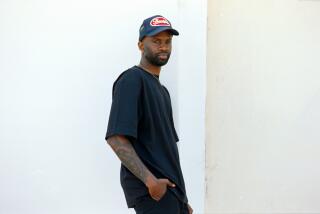Suitable for Social Framing
Even the revolution had its lighter moments. For documentary photographer Larry Fink, a committed ‘60s radical bent on exposing the ills of society through scenes of blunt tragicomedy, that meant less time in the streets and more time with the debutantes. More nights at fancy parties and the disco inferno of Studio 54.
There were gallery soirees and backwoods baptisms captured in black-and-white images that revealed a strange empathy beneath the often harsh lights and shadows of Fink’s flash. In those days, in the 1970s, Fink would indulge himself in a puff or two of marijuana, leading to some inevitable identification with the scenes of decadence unfolding before him, as his subjects drank and smoked and danced themselves into a numb stupor.
“Here are all these people who ostensibly had cash, had freedom, liberty, went to fancy parties, they did all the stuff that the common folk went, ‘Wow, what a life!’ ” says Fink, now 57. “But so often I found that because of social anxiety, and the ritual, and having so much to prove about their worth, they were really more in a dither than in ecstasy.”
In an entirely different context, Fink at the same time was photographing a rural family called the Sabatines, who lived near his home in Martins Creek, Pa. As with the socialites, he examined their life and social gatherings, but to different effect. The series sometimes overlapped--a kind of point and counterpoint between rich and poor, privileged and humble.
The resulting pictures were first gathered together in 1978 as a solo exhibition under the title “Social Graces” at New York’s Museum of Modern Art. A group of them also were published by Aperture in 1984. A 25-year retrospective of Fink’s work documenting parties and other social gatherings opened this weekend at the Jan Kesner Gallery on La Brea. The show includes images from that early New York show, as well as recent work--while the project began as a defined series, Fink has returned to it intermittently over the years.
Among the early pictures is one from 1978 of a young West Point cadet at some forgotten ball, sitting absolutely erect, the very image of discipline and cold reserve, but looking almost dummy-like beside a quartet of clowning men in tuxedos. In another image, a middle-aged man in a plaid jacket stares blankly at an array of alcohol gathered on the bar, looking grim and clearly not having the time of his life.
By contrast, an image that has become one of Fink’s best-known shows a young boy gesturing angrily as Jeannie Sabatine emerges from behind a screen door with a birthday cake. It is an image of family tension and ordinary daily interaction, a scene that could happen anywhere.
Fink does not interject himself into his pictures, yet while he is a straight documentarian, his presence is always known by his subjects. In many of his works, the flash is a dominating element, though Fink sees his light as more intimate than invasive, working as a kind of divining rod, searching aggressively for a revealing moment.
“In the earlier days, people weren’t so media-conscious, so they might be startled [by the flash],” Fink said in a phone conversation from his home in Pennsylvania. “These days everybody wants to be a star, so they’re willing to go through virtual light lobotomy.”
Early in his career, Fink would never have resorted to lighting his scenes with a strobe, since it clearly went against the idea of an invisible documentarian epitomized by such artists as Henri Cartier-Bresson. By 1974, Fink found himself moved by the imagery of ‘40s film noir and the lighting schemes found within the paintings of Rembrandt and Goya. The result is a stark personal style that has underlined his work ever since, making blunt, edgy photographs.
“The pictures started to come out with a critical heat, along with a drama and theater about life that seemed to have an individual mark,” says Fink.
Fink began his obsession with photography at 13. The son of two politically radical parents, Fink eventually took private lessons from acclaimed photographer Lissett Model in the late ‘50s. At first, he was particularly inspired by the work of Cartier-Bresson, rather than the edgier documentary work being produced during those years by the likes of Robert Frank and William Klein.
“I wasn’t particularly interested in Robert Frank,” says Fink. “I thought he was a coward. I thought his pictures were sour and not very generous. Oddly enough, my pictures at that time were the same. Because of the nature of my young anger, retrospectively they had more relationship to Robert’s work than to Cartier-Bresson.”
Fink’s first work as a photographer was for Catholic magazines based in New York, where he grew up. Dressed in a corduroy suit, he photographed at Catholic centers around the city. While he’s never been religious, he says now that his exposure to that world gave him a lasting appreciation for human spirituality.
“Here I was, a left-wing beatnik, but I was working right within the mainstream, and to this very day when I’m around people like that, or go near a church, I’m really awe-struck,” he says.
In the mid-’70s, Fink and his then-wife, painter Joan Snyder, moved to rural Pennsylvania, near Allentown. While searching for a lawn mower, Fink met the Sabatine family, an expressive crowd of parents, children and grandchildren. He spent a full decade photographing the family at his leisure.
“They had a relationship which was just as hateful as love could go,” Fink says. “My attraction to them was that everything was worn on their sleeves. Their rituals about parties were so very, very different than the Tuxedo Junction type, because everything just fell out of them.”
Fink’s work with the Sabatines, he says now, “changed me as a person, which of course changes you as a photographer. . . . It was like a lesson in what the different levels of meaning are in an event. It was also a verification of something I felt for years, which is that all of us have potential to be both good and evil, and this family certainly bore that out. I learned a lot about humankind.”
The “Social Graces” project was funded largely with two Guggenheim grants and a pair of NEA grants. The resulting show at the Museum of Modern Art earned positive reviews and some surprising fame.
“It was kind of daunting . . . because I had fashioned myself to be an underground artist, because of my politics,” Fink says. “Suddenly I was as over-ground as you could get. That put weird scars on my sense of purity. Being a leftist and against the system, and all of a sudden being accepted by the system at that point, was so weird.”
More recently, Fink published “Boxing,” a book that collects pictures from another 10-year project that began as a magazine assignment to photograph Jimmy Jacobs, who was then the manager to Mike Tyson. Next year, Fink expects to release another book on the fashion industry, a “callow and empty” world that he’s photographed off and on for the last seven years. And he also hopes to republish the “Social Graces” series.
While he is a professor of photography at Bard College in New York, Fink remains a busy editorial photographer for various publications, including Rolling Stone, the Village Voice and W. “I’m willing to work a little bit more now, because I’m getting older, and I should have some money in the bank,” he says. “Also, the revolution is stalled. So I’m here in the only game in town, which is capitalism. I try to do it with justice.”
*
“LARRY FINK: NOBLE EVENINGS AND OTHER SOCIAL GRACES,” Jan Kesner Gallery, 164 N. La Brea Ave. Dates: Tuesdays through Saturdays, 11 a.m. to 5 p.m. Ends Oct. 17. Phone: (323) 938-6834.
More to Read
The biggest entertainment stories
Get our big stories about Hollywood, film, television, music, arts, culture and more right in your inbox as soon as they publish.
You may occasionally receive promotional content from the Los Angeles Times.











